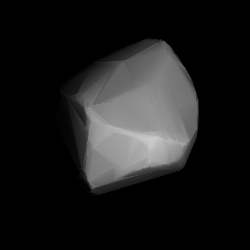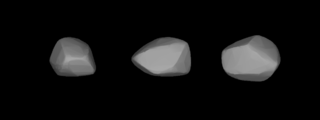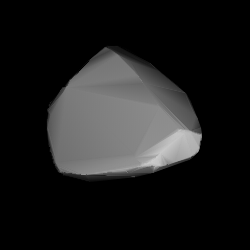Related Research Articles

199 Byblis is a medium-sized main belt asteroid.

366 Vincentina is a fairly large main belt asteroid.

237 Coelestina is a typical main belt asteroid.

241 Germania is a very large main-belt asteroid. It is classified as a B-type asteroid and is probably composed of dark, primitive carbonaceous material.

260 Huberta is a large asteroid orbiting near the outer edge of the Main belt. It is dark and rich in carbon.

263 Dresda is a typical Main belt asteroid. It belongs to the Koronis family of asteroids.

267 Tirza is a fairly sizeable, very dark Main belt asteroid.

312 Pierretta is a 46 km main-belt asteroid discovered on 28 Aug 1891 by Auguste Charlois at Nice.

343 Ostara is a background asteroid from the inner region of the asteroid belt. It was discovered by German astronomer Max Wolf at the Heidelberg Observatory on 15 November 1892.

351 Yrsa is a typical Main belt asteroid. It was discovered by Max Wolf on 16 December 1892 in Heidelberg.
443 Photographica is a typical Main belt asteroid. It is classified as an S-type asteroid.

534 Nassovia is a minor planet orbiting the Sun. It is a member of the Koronis family of asteroids.

621 Werdandi is a Themistian asteroid.
633 Zelima is a minor planet orbiting the Sun in the asteroid belt with a magnitude of 10.7. The name may have been inspired by the asteroid's provisional designation 1907 ZM.

662 Newtonia is a minor planet, specifically an asteroid orbiting mostly in the asteroid belt.
668 Dora is an asteroid orbiting in the asteroid belt located roughly between the orbits of the planets Mars and Jupiter. The name may have been inspired by the asteroid's provisional designation 1908 DO.
768 Struveana is a minor planet orbiting the Sun. The asteroid was named jointly in honor of Baltic German astronomers Friedrich Georg Wilhelm von Struve, Otto Wilhelm von Struve and Karl Hermann Struve.

1694 Kaiser is a carbonaceous background asteroid from the inner regions of the asteroid belt, approximately 16 kilometers in diameter. It was discovered on 29 September 1934, by Dutch astronomer Hendrik van Gent at Leiden Southern Station, annex to the Johannesburg Observatory in South Africa. It is named for Dutch astronomer Frederik Kaiser.
6144 Kondojiro (1994 EQ3) is an asteroid discovered on 14 March 1994 by Kin Endate and Kazuro Watanabe at the Kitami Observatory in eastern Hokkaidō, Japan. It is named after Jiro Kondo, a Japanese Egyptologist and professor of archaeology at Waseda University.
2021 LL37 is a large trans-Neptunian object in the scattered disc, around 600 kilometres (370 miles) in diameter. It was discovered on 12 June 2021, by American astronomers Scott Sheppard and Chad Trujillo using Cerro Tololo Inter-American Observatory's Dark Energy Camera in Chile, and announced on 31 May 2022. It was 73.9 astronomical units from the Sun when it was discovered, making it one of the most distant known Solar System objects from the Sun as of May 2022. It has been identified in precovery images from as far back as 28 April 2014.
References
- ↑ "818 Kapteynia (1916 YZ)". JPL Small-Body Database . NASA/Jet Propulsion Laboratory . Retrieved 4 May 2016.